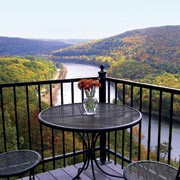Dead set against living in the past, the Catskills region is staging a comeback. Home to the Hunter, Windham, Belleayre, and Plattekill ski areas, the Shawangunk Mountains, and more than 30 peaks topping 3,500 feet, skiers, hikers, bikers, kayakers, climbers, and autumn leaf peepers are discovering an area that was once known as the Jewish Alps.
Comprised of four counties, Delaware, Greene, Ulster, and Sullivan, it’s the latter two whose resorts hosted the likes of Woody Allen, Jackie Mason and Mel Brooks, and spawned one-liners such as Henny Youngman’s “Take my wife, please.” In the peak of the Golden Age, which lasted from 1940 to the mid-’60s, there were 538 hotels concentrated in Sullivan County and a small section of Ulster County, which became known as the Borscht Belt for its mostly Jewish clientele. Today only a handful of those remain.
“People used to be out and about in the village of Monticello and Liberty,” says John Conway, Sullivan County historian. “You had trouble walking down the sidewalk, it was shoulder to shoulder.”
The Catskills first emerged as a retreat in the mid-19th century, with between 200 and 300 hotels by 1890, during what Conway calls the Silver Age.
“The region grew around the railroad,” Conway says. “It was marketing fresh air and clean water, which was supposed to have curative powers. Next to the Adirondacks, it was the most famous healing spot for tuberculosis in America. With the influx of Eastern European Jews in the 1920s and ’30s, hotels transformed.”
Mega-resorts like Grossinger’s and Concord opened, where guests escaped the city’s summer heat and never left the resort. But by the mid-’60s everything changed.
“You had the three A’s—airplane travel, air-conditioning and assimilation,” Conway explains. “A lot of the larger fortress hotels managed to stay on. But they didn’t feed into the local economy.”
Most closed, though Kutscher’s Country Club still functions as a resort and is celebrating its 100th birthday this year. Concord Resort Hotel and Golf Club, featuring the famed Monster golf course, is under renovation to be reopened at a future date, and Grossinger’s Country Club now operates only as a golf course. The Friar Tuck, which first opened in 1971, is now the elaborate Friar Tuck Resort, Spa and Conference Center.
The Catskills region gained headline status once again in 1969, this time for a different form of entertainment, Woodstock. But the overall Catskills decline continued, with many areas becoming ghost towns.
In the late ’80s, as urban real estate prices soared, the Catskills opened to second-home buyers, sparking a slow but steady resurgence. The region is known today as The Hamptons North.
“Each county has turned into a more sophisticated, hip destination than what people think of the Catskills,” says Daniela Marino, director of the Greene County Tourism Office and president of the Catskill Regional Association, a marketing group for all of the counties comprising the Catskill region.
Now, towns like Liberty, Jeffersonville and Ferndale feature antique shops, while New Paltz is part of the Shawangunk Wine Trail. The Catskills is where painter Thomas Cole settled and founded the Hudson River School of art. His home and studio, now the Thomas Cole National Historic Site in Cedar Grove, are open to visitors and groups.
Bethel Woods Center for the Arts debuted last year at the site of the first Woodstock. Other cultural outlets include the Windham Fine Arts Center, Forestburgh Playhouse, now in its 60th year, and the Catskill Fly Fishing Center and Museum.
Trendy hotels are also beginning to open, with The Roxbury and its funky decor leading the way. On the horizon is a 400-room spa in Forestburgh. Villa Roma Resort and Conference Center, which suffered heavy damage from a fire last year, will reopen with larger suites by this winter.
In Sullivan County, the Monticello Gaming & Raceway draws for its horse track and video slot machines. There is continued talk of the St. Regis Mohawk casino opening at Monticello Raceway, but nothing has been finalized.
There is speculation whether a casino will boost tourism. “Nobody knows what a casino would do,” Conway says. “That’s the $64,000 question.”







